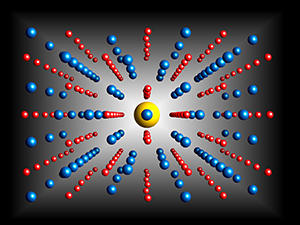

03/25/2013

© 2013 Mingwei Chen
Supercapacitors aim to surpass batteries by combining immense energy storage with lightening-quick charge times. Manganese oxide (MnO2) is a promising material for these devices because of its low cost, nontoxic properties and ultrahigh capacitance. However, the compound’s intrinsically low conductivity renders electron transport difficult. So far, only nanometer-thin films or low-density nanoparticle dispersions of MnO2 have displayed the desirable supercapacitance, but unfortunately these structures are too small to deliver adequate power for most applications.
Mingwei Chen, Jianli Kang and colleagues from the AIMR at Tohoku University have now devised a strategy to boost the conductivity of MnO2 thick films by fashioning them into unconventional nanoporous electrodes that incorporate gold atoms within their oxide lattice1. First, the team synthesized a porous MnO2 electrode by electrochemically depositing a nanoscale film with needle-like arrangements onto a gold–polymer substrate. Despite the structure providing plenty of surface sites for energy storage, the electrode’s capacitance dropped dramatically when the film’s thickness exceeded 350 nanometers, owing to MnO2’s poor conductivity.
The researchers then bombarded the MnO2 electrode with gold atoms from a physical vapor deposition system, using a process known as sputtering. Repeating the sequence of MnO2 electrochemical growth followed by gold ‘doping’ several times enabled the construction of micrometer-thick electrodes ready for use as supercapacitors. X-ray and electron microscopy analysis revealed that this technique replaces 10% of the MnO2 with electron-rich gold dopant atoms that are distributed evenly throughout the oxide (see image). Alternate layering of MnO2 and gold atoms ensures the dopants are well-integrated within the oxide’s lattice and not just physically absorbed, Chen notes. “The electrochemical deposition helps sputtered gold travel to the electrode/electrolyte interface to occupy MnO2 lattice sites.”
The gold-doped MnO2 was found to have a capacitance 65% higher than that of comparable pure films — the best charge storage ever achieved from thick MnO2 electrodes. The new material showed outstanding stability and even increased its charge capacity after a few hours’ use due to electrochemical dopant redistribution during voltammetric cycling. Collaboration with Kazuto Akagi’s research team at the AIMR uncovered a fundamental theoretical principle behind these findings: gold dopants transfer electrons to manganese and oxygen atoms equally, boosting the entire material’s conductivity.
“Manganese oxide is the most promising material for electrochemical supercapacitors,” says Chen, adding that “doping is the easiest and best way to improve its conductivity.” By implementing an often-considered but rarely realized concept, the team is confident that their doping approach will benefit future commercialization efforts of MnO2 thick-film devices.
Kang, J., Hirata, A., Kang, L., Zhang, X., Hou, Y., Chen, L., Li, C., Fujita, T., Akagi, K. & Chen, M. Enhanced supercapacitor performance of MnO2 by atomic doping. Angewandte Chemie International Edition 52, 1664–1667 (2013). | article
This research highlight has been approved by the authors of the original article and all information and data contained within has been provided by said authors.